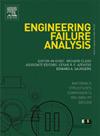Tribological failure mechanisms and mitigation strategies for bevel gear differentials in electric vehicles
IF 5.7
2区 工程技术
Q1 ENGINEERING, MECHANICAL
引用次数: 0
Abstract
During start-up, rapid acceleration, and energy regeneration (involving alternating forward and reverse rotation), electric vehicle (EV) drivetrains-including reduction gears and differentials-are subjected to higher instantaneous torque loads, significantly increasing the risk of component failures such as wear compared to internal combustion engine vehicles. Investigating wear failures and their mechanisms in differentials under high-load conditions is essential for enhancing the operational safety and stability of EVs. In this study, a durability bench test was conducted on the differential of a specific EV model under differential-speed and torque-bias conditions. The wear behavior of key components was analyzed and characterized. Experimental results revealed typical wear failures such as circumferential furrow, adhesive wear, and plastic deformation on the planetary gear shafts and the inner bores of the planetary gears. Contact behavior analysis indicated that the overturning displacement of the planetary bevel gears under meshing force causes localized contact pressure concentrations at the shaft-bore interfaces, which are likely the main cause of the observed surface wear. Modifying the geometry of the planetary gear bore (i.e., surface modification) was found to be an effective strategy for relieving stress concentrations. An optimal modification amount exists that minimizes contact pressure at the shaft-bore interface without introducing new stress concentration zones. The findings not only elucidated the failure mechanism, but also yielded operative geometric optimization strategies based thereon, thereby providing theoretical underpinnings for anti-wear design and service life enhancement of electric vehicle differentials.
电动汽车锥齿轮差速器的摩擦学失效机理及缓解策略
在启动、快速加速和能量再生(包括交替前进和反向旋转)过程中,电动汽车(EV)传动系统(包括减速齿轮和差速器)承受更高的瞬时扭矩负载,与内燃机汽车相比,显著增加了部件故障(如磨损)的风险。研究高负载条件下差速器的磨损故障及其机理,对于提高电动汽车的运行安全性和稳定性至关重要。在本研究中,对某型号电动汽车在差速和偏矩条件下的差速器进行了耐久性台架试验。对关键部件的磨损行为进行了分析和表征。实验结果表明,行星齿轮轴和内孔存在典型的周沟磨损、黏着磨损和塑性变形等磨损失效。接触行为分析表明,行星锥齿轮在啮合力作用下的倾覆位移导致轴-膛界面局部接触压力集中,这可能是造成表面磨损的主要原因。修改行星齿轮孔的几何形状(即,表面改性)被发现是缓解应力集中的有效策略。在不引入新的应力集中区的情况下,存在一个使轴-孔界面接触压力最小的最佳改性量。研究结果不仅阐明了差速器的失效机理,而且在此基础上提出了可操作的几何优化策略,为电动汽车差速器的抗磨设计和延长使用寿命提供了理论依据。
本文章由计算机程序翻译,如有差异,请以英文原文为准。
求助全文
约1分钟内获得全文
求助全文
来源期刊

Engineering Failure Analysis
工程技术-材料科学:表征与测试
CiteScore
7.70
自引率
20.00%
发文量
956
审稿时长
47 days
期刊介绍:
Engineering Failure Analysis publishes research papers describing the analysis of engineering failures and related studies.
Papers relating to the structure, properties and behaviour of engineering materials are encouraged, particularly those which also involve the detailed application of materials parameters to problems in engineering structures, components and design. In addition to the area of materials engineering, the interacting fields of mechanical, manufacturing, aeronautical, civil, chemical, corrosion and design engineering are considered relevant. Activity should be directed at analysing engineering failures and carrying out research to help reduce the incidences of failures and to extend the operating horizons of engineering materials.
Emphasis is placed on the mechanical properties of materials and their behaviour when influenced by structure, process and environment. Metallic, polymeric, ceramic and natural materials are all included and the application of these materials to real engineering situations should be emphasised. The use of a case-study based approach is also encouraged.
Engineering Failure Analysis provides essential reference material and critical feedback into the design process thereby contributing to the prevention of engineering failures in the future. All submissions will be subject to peer review from leading experts in the field.
 求助内容:
求助内容: 应助结果提醒方式:
应助结果提醒方式:


